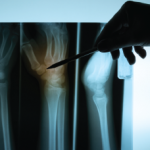NEW YORK (Reuters Health)—A “biomechanical” analysis of a previously taken pelvic or abdominal computed tomography (CT) scan is at least as accurate in assessing an individual’s hip fracture risk as a dual-energy X-ray absorptiometry (DXA) scan, according to new research.
This accuracy of the hip bone mineral density (BMD) T-score as measured by the biomechanical CT (BCT) analysis was consistent for all fracture-risk metrics and both sexes, researchers found in a retrospective case-cohort study of nearly 4,000 participants.
Further, combining the classifications of fragile femoral bone strength and hip osteoporosis from BCT data resulted in higher sensitivity than the standard hip/spine osteoporosis classification by DXA, with comparable specificity.
In people who are already having a CT done for some other reason, particularly those aged 65 or older, “we can now screen them for osteoporosis simultaneously, sparing them the need for a separate DXA scan,” lead author Dr. Annette Adams of Kaiser Permanente Southern California tells Reuters Health by email. “Additionally, by screening the CT scans, we may pick up some people with osteoporosis or fragile bone strength who wouldn’t otherwise be screened by DXA.”
“This is significant,” she adds, because if an individual is identified as having osteoporosis, they can receive care to reduce the risk of a fracture. Such care could include medication, taking calcium and vitamin D, regular exercise and avoiding excessive tobacco and alcohol.
“When you save an older person from a fracture, you just may be saving their life,” Dr. Adams says.
The findings were published online April 17 in the Journal of Bone and Mineral Research.1
The researchers used data on more than 111,000 Kaiser Permanente patients who were 65 or older and had had a DXA scan within three years of a CT scan and no hip fracture before either scan. From this population, they matched 1,959 patients who later experienced a first non-traumatic hip fracture with 1,979 who did not.
BCT analyses of all participants’ existing CT scans were performed at a single lab that was blinded as to hip fracture status, clinical factors and DXA date.
Patients who fractured a hip were older, had lower BMD and lower body mass index and included more whites and fewer Asians, blacks and Hispanics.
Combining the classifications of fragile femoral bone strength and hip osteoporosis from BCT data resulted in higher sensitivity for predicting hip fracture than the standard hip/spine osteoporosis classification by DXA (0.66 vs. 0.59 for women; 0.56 vs. 0.48 for men), with comparable specificity (0.66 vs. 0.67 and 0.76 vs. 0.78, respectively).

